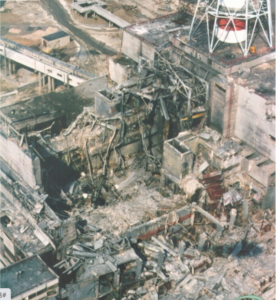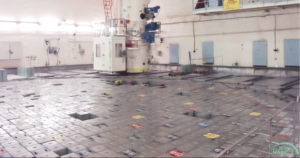Insightful courage in an age of volatility
Leadership and organizational success today – bearing up under repeated shocks and facing what McKinsey calls “the most challenging environment management teams have ever faced” – requires courageous insight, commitment, and execution to create truly fresh opportunities in a disruptive age of volatility. How can this be achieved?

Such commitment represents earnest focus in an all-but-official 21st century “VUCA world” – a military acronym describing a challenging state of relentless “volatility, uncertainty, complexity, and ambiguity.”
How can a leader react in such times? As one former racing champion noted, “You cannot overtake 15 cars in sunny weather, but you can when it’s raining.” McKinsey suggests that in this age of volatility, insightful leaders will be “changing to wet-weather racing tires and stepping on the gas.”
Anticipating the days ahead leading into 2023, a recent McKinsey analysis details two general expected types of leaders to emerge: those rigidly adopting a cost-cutting defensive stance, and those who strategically embrace an agile posture of being “prudent about managing the downside while aggressively pursuing the upside.”
What does this look like?
An “insights” advantage
A critical step forward secures an “insights edge.” This includes gaining as full visibility as possible into internal and external forces, anticipating disruptive changes while identifying and discarding old, potentially harmful approaches and corporate culture.

Are there lessons to be learned from volatile situations in the past? The recent passing of Mikhail Gorbachev can bring fresh awareness to consider what happened to a once-vibrant transformational Soviet initiative, punctuated by fatal volatility that ultimately doomed a nation in then-potential recovery.
Further, in this vein, vital insight can be achieved by examining contemporary parallels between today’s “challenging environment” and what led up to the infamous Chernobyl (Ukraine: Chornobyl) nuclear disaster. Initially, the cause of the disaster was pinned on a series of errors committed by Chernobyl control room staff. But a review of history and a root cause analysis reveals much more – including possible parallels to what might be quietly going in your company or organization today.

While we bring insightful leadership to the fore, how can one avoid a Chernobyl-level disaster during our present age of volatility? Let’s briefly consider what happened on that fateful night at the Soviet Union’s flagship nuclear reactor and what led up to it.
A deadly outcome – positive void coefficient
Around the middle of that fateful April night 36 years ago, harried Soviet nuclear technicians unwittingly forced a fatally flawed RBMK-1000 nuclear reactor to the brink of a superheated abyss, triggering an unrecoverable “positive void coefficient.” Minutes after staff effectively lost control of the massive Unit 4, a worst-case accident tore the reactor apart. Upwards of 2,000 tons of highly radioactive steam, vaporized nuclear fuel, and blazing chucks of graphite exploded through the reactor’s roof, spawning the industry-feared “General Radiation Accident.” The ensuing disaster generated continent wide contamination, economic upheaval, and loss of life.

Mikhail Gorbachev, then-the innovative leader of the Soviet Union, instantly faced a severe conundrum. To the open cheers of the world, Gorbachev had previously instituted new policies of glasnost (“transparency, openness”) and perestroika (“restructuring”) to reform the stagnant Soviet economy and political bureaucracy.
The catastrophic disaster at Chernobyl cracked open deadly political fissures across these ambitious reforms, leading straight to the demise of the Soviet Union.
Why is this important in a 21st century age of volatility?
The Chernobyl staff weren’t the full cause of the nuclear disaster. Decades of repeated flawed reactor design, ruthlessly cheap and shoddy materials, corrupt or completely absent safety measures, and stifled communication from the uber-secret U.S.S.R Sredmash/Ministry of Medium Machine Building institute condemned the power plant – and ultimately the country – before its foundations were even poured.
As you plan bold strategic choices to deal with the current age of volatility, consider what transformed the Russian best-performing nuclear reactor to a word that equates today with massive disaster and failure:
The Soviet Union originally was a recognized early innovator in nuclear reactor science. Unfortunately, domestic reactor designs to produce electrical power borrowed heavily from military reactor designs that held a dramatically different purpose, that of producing weapons-grade nuclear material.
The outcome? Serious and potentially deadly flaws in reactor design were passed down and multiplied generation after generation. Cost-cutting measures ruled (ironically, the same mindset produced the long covered-up 1957 Windscale domestic nuclear disaster in the United Kingdom).
The construction of the Chernobyl reactors was plagued with substandard materials; key critical components often arrived at the Ukrainian worksite with deep and serious flaws; installing these compromised components would yield a high danger of failure. Costly reconstruction and rehab of key parts had to take place, producing a new formal process: “Pre-install Overhaul.”

The point? A profound problematic mindset essentially doomed the Chernobyl plant from the blueprint stage on. The Soviets cheaped everything out, including substituting inferior quality of nuclear fuel, which contributed to unstable reaction operation, and omitting a standard containment vessel around the reactor, which subsequently allowed uncontrolled continental radioactive contamination from the explosion.
Any of this sound familiar? Are you concerned about corporate culture at your company and its fatigued employee capacity to embrace a new change management initiative to seize opportunities? For certain, balance sheet management in volatile times represents a critical focus. But courageous leaders hold a different mindset – they carve out financial resilience specifically to seize new opportunities while others wait and see. How does one positively achieve that?
“Sullen indifference”
Back in the Soviet Union, severe culture challenges existed aplenty. Here’s a key point to consider in today’s VUCA environment: “The [Soviet] Era of Stagnation had fomented a moral decay in the Soviet workplace and a sullen indifference to individual responsibility, even in the nuclear industry,” according to Midnight in Chernobyl author Adam Higginbotham (emphasis added).
Do you see “sullen indifference” in your company today? Do leadership and communication gaps contribute?
Back at the former pride of Soviet reactor fleet being built in Ukraine, rigid resistance to improving processes – “this is the way we’ve always done it” – and self-serving approaches reigned. As a result, shortcuts commonly surfaced and required critical safety tests were delayed (the No. 4 Chernobyl accident was the result of a botched catch-up safety test) or thrown under the nuclear bus.
Everything led up to a deadly night of a perfect storm. And, as a number of analysts believe, on the night of the Chernobyl disaster, the Soviet Union began fatally fracturing apart, eventually collapsing into a splintered heap together with the hopes of Mikhail Gorbachev and his reforms.
Is there a Chernobyl lurking in your company? Has senior management – or even your board – created a ticking time bomb waiting for its own “positive void coefficient”?
Achieving change – “value from volatility”
Culture and political shocks continue today, but McKinsey sees real prospects for ambidextrous leaders who “rethink opportunities and reset the strategic gameboard in light of the current volatility.”

These leaders will dedicate critical strategic assets to gaining an insights edge that “generates great value…seeing accurately through the fog [at least] 10 percent more often than your rivals.”
Second, McKinsey notes that “as important as knowing what to do is doing it promptly and with sufficient ambition.”
Thirdly, the McKinsey authors emphasize strategic execution: “the ability to rapidly pivot in response to changing conditions.” This embraces “speed: getting things done well and fast.”
In their concluding research, the authors encourage leaders to embrace this: “times of crisis, disruption, and volatility require courage from leaders to make bold strategic choices.”
We also note with proper humility that the McKinsey authors openly reflect a long-time MEK value, expressed here in Latin: fortuna favet fortibus. “Those who move early and at scale gain significant advantages. In other words, fortune favors the bold.” It should be noted that MEK also long has valued and championed the development of actionable insight for its clients; hence the “knowledge” element in the name, “marketing, engagement, knowledge.”
Now is the time to identify and clean out any possible remaining Chernobyl in your company organization. Now is the time to address volatility, uncertainty, complexity, and ambiguity with courage, insight, commitment and execution.
By Michael Snyder, MEK Among other relevant industry experience and depth in corporate transformation and strategic communication, Snyder holds an honors MBA from Cal State Los Angeles, one of the top five percent business programs worldwide.
One thought on “Insightful courage in an age of volatility”
Comments are closed.

Thank you for a stimulating presentation. “Fortune Favors the Bold” with marketing, engagement, and knowledge is still a volatile generalization. Under the circumstances of pending volatility, the immeasurable consequences of being bold might be overwhelmingly destructive, reaching that “critical mass” we look to avoid. In other words, we may only have one shot to get it right. The ability to move quickly is a keen advantage but that same ability might be all you’re allowed in order to survive and live to fight another day. While on one hand “He who hesitates is lost” …the balancing caution is worthy of heeding too: “Haste makes waste.” Beware of Pride entering into the equation. While knowledge is critical to lead engagement, knowledge tempered with pride may cause that “positive void” that was so devastating at Chernobyl. Since the Proverb stands: “Pride goes before the fall.” then it’s also clear that the problem to all these attempts to mitigate destruction from volatility or boldness is evidently a spiritual problem which must include spiritual solutions. Humanism is a built-in problem not to be trusted or ignored in this equation.